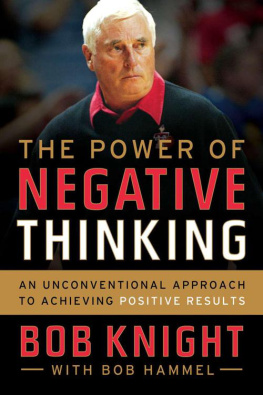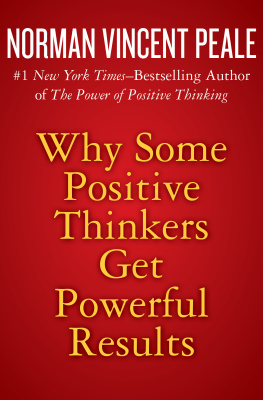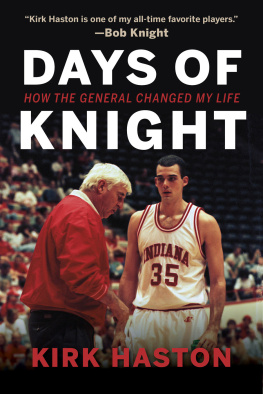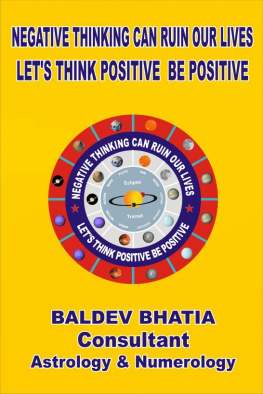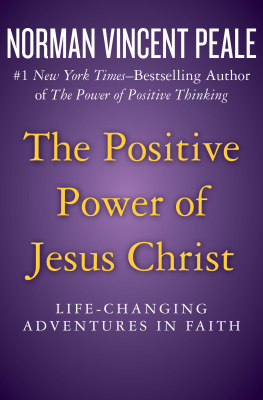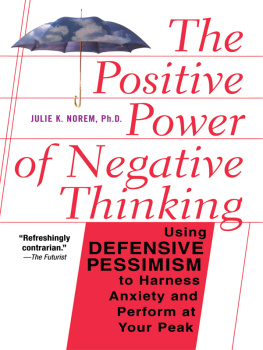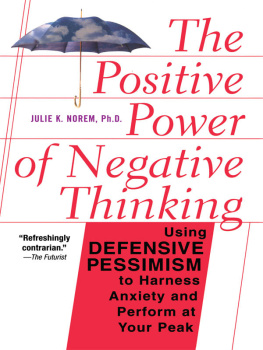

Text copyright 2013 by Bob Knight
All rights reserved.
No part of this book may be reproduced, or stored in a retrieval system, or transmitted in any form or by any means, electronic, mechanical, photocopying, recording, or otherwise, without express written permission of the publisher.
Published by Amazon Publishing
P.O. Box 400818
Las Vegas, NV 89140
ISBN-13: 9781477807248
ISBN-10: 1477807241
To my grandmother, born in 1878, who first taught me about negative thinking when she said, If wishes were horses, beggars would ride.
CONTENTS
INTRODUCTION
Many of us are not aware of our optimistic tendencies. Data clearly shows that most people overestimate their prospects for professional achievement; expect their children to be extraordinarily gifted; miscalculate their likely life span; expect to be healthier than their peers; hugely underestimate their likelihood of divorce, cancer, and unemployment; and are confident overall that their future lives will be better than those their parents put up with. This is known as the optimism biasthe inclination to overestimate the likelihood of encountering positive events in the future and to underestimate the likelihood of experiencing negative events.
The Optimism Bias: A Tour of the Irrationally Positive Brain
(TALI SHAROT, PANTHEON BOOKS, 2011)
T HERE IS, ADMITTEDLY, a large helping of my version of humor in the title chosen for this book, an obvious play on a work that has been almost a bible for much of America most of my lifetime: The Power of Positive Thinking by Norman Vincent Peale.
It came out in 1952, when I was in elementary school. It sold more than two million copies its first year out, and its still in print, with total copies sold now over five million. Taking the opposite position starts me out millions of books behind in the sales race. Im very comfortable being a contrarian and stating my argument for The Power of Negative Thinking.
I didnt know, until I did a little research for this book, that Norman Vincent Peale also is from northern Ohio. Were separated by two generations, born and reared about 100 miles apart; hes from the western side of the state, and I hail from the east. That makes us products of pretty much the same middle-American, small-town upbringing and culture, each of us even raised in the same Methodist denomination. He switched to Dutch Reformed; I am more of a theological free agent, though definitely more theo- than atheo-.
For all his book-selling, preaching, lecturing, and TV success, the Rev. Mr. Peale did have his disbelievers. His partner in a couple of earlier psychological-theological books split with him over The Power of Positive Thinking. Thought it could be dangerous. To at least some degree, so does Tali Sharot, apparently.
There is a story that Democratic presidential candidate Adlai Stevenson was advised before a campaign speaking appearance at a church that he probably wouldnt get any votes out of the audience, because Bishop Peale had urged his followers to vote as a bloc for Republican candidate Dwight D. Eisenhower. His own biblical knowledgeand witshowing, Stevenson quipped in response: I find Paul appealing and Peale appalling.
I was too young to vote at the time, but Im sure Id have gone for Eisenhower over Stevenson both times they ran. Still, give Stevenson his duehe knew what it meant to be an underdog and kept his sense of humor.
Beneath the irony of turning Peale upside down, her book offers a thesis that I have advocated for years. Ms. Sharot is described on her book jacket as a researcher on optimism, memory, and emotion with a Ph.D. in psychology and neuroscience from New York University, and a research fellow at the Wellcome Trust, among other academic positions. In Orrville, Ohio, that would raise skeptical eyebrows, but it is interesting company for a basketball coach.
In her book The Optimism Bias, Ms. Sharot states:
The reality is that most people perceive themselves as being superior to the average human being. A survey conducted in the mid-1970s revealed that 85 percent ranked themselves in the top 50th percentile for the ability to get along well with others and 70 percent did so for leadership ability. Another survey showed that 91 percent believed they were in the top 50th percentile for driving ability. [I]mpossible. Most people cannot be better than most people. We can, however, all believe that we are at the high end on most positive attributes, and indeed we do. This is known as the superiority illusion.
I dont agree totally with her conclusions. Im a basketball coach who tends from experience and instinct to see more graphically the things she describes intellectually. But I wholeheartedly agree that we as people and as a nation are by nature inclined to see things optimisticallyabove and beyond any push in that direction by the Rev. Mr. Peale. And I do see some dangers in thatas I did for more than forty years of coaching college basketball. What seems too good to be true usually isthere is a genuine need to be cautious, to look both ways before crossing any streets in life. Paying attention to the downside is a difficult but essential quality for achieving long-term success in any occupation or family situation.
Throughout this book, I will speak largely as a coach, in coaching and basketball terms. And since my turf was mens basketball, I am going to be using the he pronoun more than she. But I intend everything to be interpreted much more broadly than that, for both sexes and metaphorically, because the principles I established and followed in coaching carry over perfectly to the way I think leadership works best in business or any other area of life. Coaching is leadership, and leadership is leadership, whether in a gym, an office, a classroom, or a family.
Let me be clear: I am not arguing for being a strict negativist, for walking around with a sour look, for always seeing the dark side, always expecting failure. Thats not my intent at all. Quite the opposite.
Im saying that being alert to the possible negatives in any situation is the very best way to bring about positive results. And the reverse is true, tooignoring or failing to spot potential hazards in advance makes failure all the more likely. For example, Im talking about being aware that it can rain. You can plan the greatest outdoor event in the worldfood, games, entertainment, decorationsbut if a rain shower would turn everything into chaos and you dont allow for that possibility, youre risking disaster because of blind optimism.
Dont be caught thinking something is going to work just because you think its going to work.
Planning beats repairing.
And good planning avoids the need for fixing up a project that plowed ahead without thought at all about potential pitfalls.
Stop and think. Thats a phrase weve all used to introduce a new way of considering something, to argue for stepping back from a situation and looking at it in an all-new light.
Stop and think: Thats what Im saying is always the best approach before rushing forward with carried-away zeal.
One of our most lauded qualities is the ability to think fast. In an emergency, thats great. But its also risky. When time permits, its much better to be sure youre thinking clearly. How many times have we read or heard of someone who made a rash decision and now faces criminal charges, or lost his job, or broke his family apart by an unwise act? There are so many unintended consequences in any important action that we need to at least consider, like the best chess player, how our next move could produce an unexpected chain reaction down the line.
Next page
